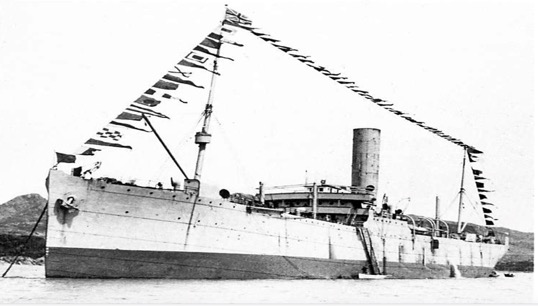Lake Champlain

The build
The Lake Champlain was a four-masted steel screw steamer built by Barclay, Curle & Company for its Beaver Line service in 1900. The ship came in at 7,392 grt and was 446 ft (136m) long. Initial passenger capacity was 680, which was then increased to 1,300 in 1906 after a change in ownership.
Deployments
The Lake Champlain had a varied career during its years active, travelling from Britain to the Far East.
First deployed on 21 May 1901, the Lake Champlain set sail from Liverpool to Quebec and Montreal, Canada, where it carried out a series of radio communications experiments between 1901-1903.
After completing a transatlantic crossing with its new owners, Canadian Pacific Railways, the Lake Champlain was re-named Ruthenia and switched to a service between Trieste and St John, Newfoundland in 1913.
The Ruthenia was then acquired by the British Expeditionary Force and began its service in the First World War as a transport ship between August and October 1914. In November, the Ruthenia was re-named HMS King George V, becoming one of fourteen merchant ships transformed into dummy battleships as part of a special squadron.
Once this squadron was disbanded in 1916, the Ruthenia reverted to Royal Fleet Auxiliary (RFA) service as a stores ship and operated as a water carrier at Scapa Flow until the end of WW1.
Post-war, the ship was fitted with two cylindrical tanks in 1919 to carry up to 5,000 tons of oil. The Ruthenia undertook refuelling and replenishment duties based in Hong Kong until 1927. In 1929, it switched roles, becoming a naval oil fuel jetty and pumping station in Singapore.
During the Second World War, the Ruthenia was captured by the Japanese after they invaded Singapore in February 1942. It was re-named Choran Maru and was used to carry oil between Sumatra and Singapore until it was re-captured by the Royal Navy in September 1945.
In its final years, the Ruthenia undertook several voyages between Singapore and Japan to repatriate prisoners of war before being sold for scrap in 1949.
Lake Champlain Fact File
Where was the Lake Champlain built?
The Lake Champlain was built in Glasgow, Scotland by Barclay, Curle & Company.
How big was the Lake Champlain?
The steamship was 446 ft (136m) long and the original tonnage was 7,392 grt.
What was the Lake Champlain famous for?
The Lake Champlain was the first British merchant ship to go to sea with a permanent wireless telegraphy system.
How many name changes did Lake Champlain have?
The Lake Champlain was re-named four times, from Ruthenia to HMS King George V to Choran Maru, and then back to Ruthenia.
What year did the Lake Champlain stop operating?
The ship ended its service in 1949, after undertaking a series of voyages between Singapore and Japan to repatriate prisoners of war.
Claim to fame
On 21 May 1901, the Lake Champlain became the first British merchant ship to go to sea with a permanent wireless telegraphy system supplied by the Marconi company. This equipment had to be fitted into a specially constructed windowless cabin measuring less than 16 sq ft (1.49 sq m).
During its voyage to Canada, several radio communications experiments were carried out. An exchange of messages took place with the new radio stations at Holyhead and Rosslare from up to 37 miles. On its return, there was another successful exchange of messages with the Cunard liner Lucania.
Ownership
The Lake Champlain was built as a British merchant ship, changing ownership several times from Canadian ownership to variants within the British forces.
In February 1903, the Lake Champlain was acquired by Canadian Pacific Railways, and made the company’s first transatlantic crossing from Liverpool to Montreal in April that year. After incurring some damage from collisions with icebergs in 1909 and 1911, and undergoing a name change to Ruthenia, it then began service as a transport ship for the British Expeditionary Force in August 1914.
Soon after this, the vessel was renamed to HMS King George V. After an ill-fated scheme created to fool the Germans, HMS King George V became the Ruthenia again and she reverted to RFA service in 1916 until the end of the war.
The Ruthenia's next change in ownership took place during WWII, when it was captured by the Japanese in February 1942 after becoming scuttled. Finally, it was recaptured by the Royal Navy in September 1945, and served its last few years in the RN until it was towed from Singapore to Scotland by the tug Englishman in 1949, and was broken up at Dalmuir.
Contribute
Are you knowledgeable about this vessel?
Submit your contribution to this article to our editorial team.
Write to usView more ships of the past
HMS Beagle
Launched 200 years ago, HMS Beagle has been described as one of the most important ships in history – thanks to the observations on evolution and natural selection that its famous passenger Charles Darwin made during a five-year voyage around the world between 1831 and 1836.
Common.ReadMoreHMS Beagle
Manchester Challenge
Launched in June 1968, Manchester Challenge was one of the first British-built and operated cellular containerships, and it entered service in November that same year.
Common.ReadMoreManchester Challenge
Esso Ulidia
Delivered in October 1970, Esso Ulidia was one of eight 250,000dw-plus ships, which were all named after old British and Irish kingdoms, to be constructed for Esso's red ensign fleet between 1969 and 1973.
Common.ReadMore